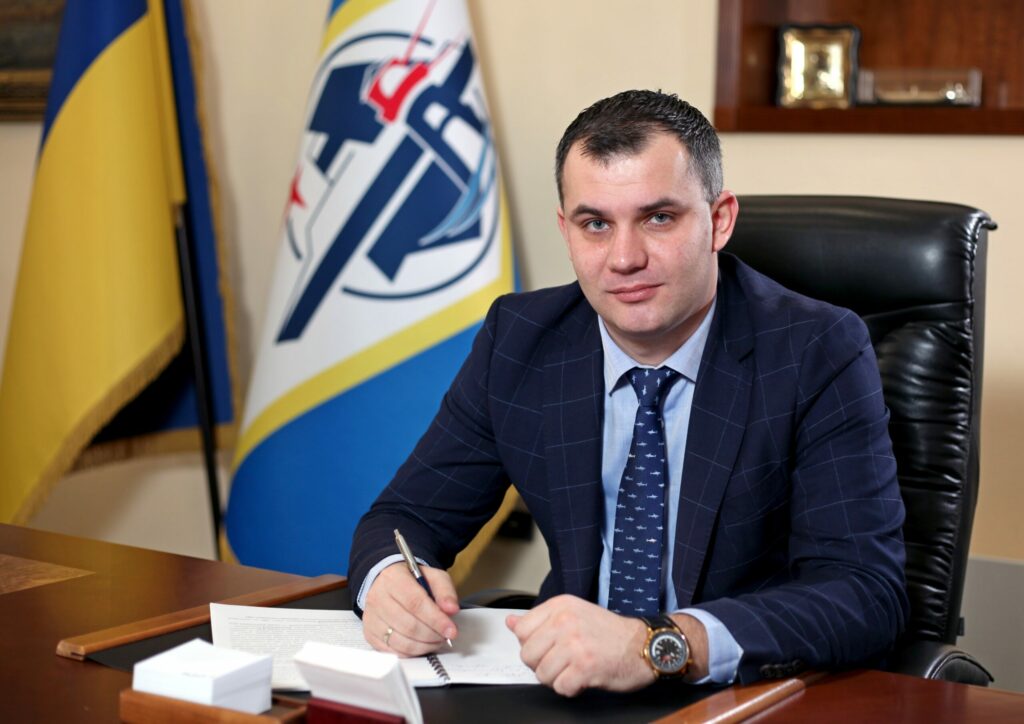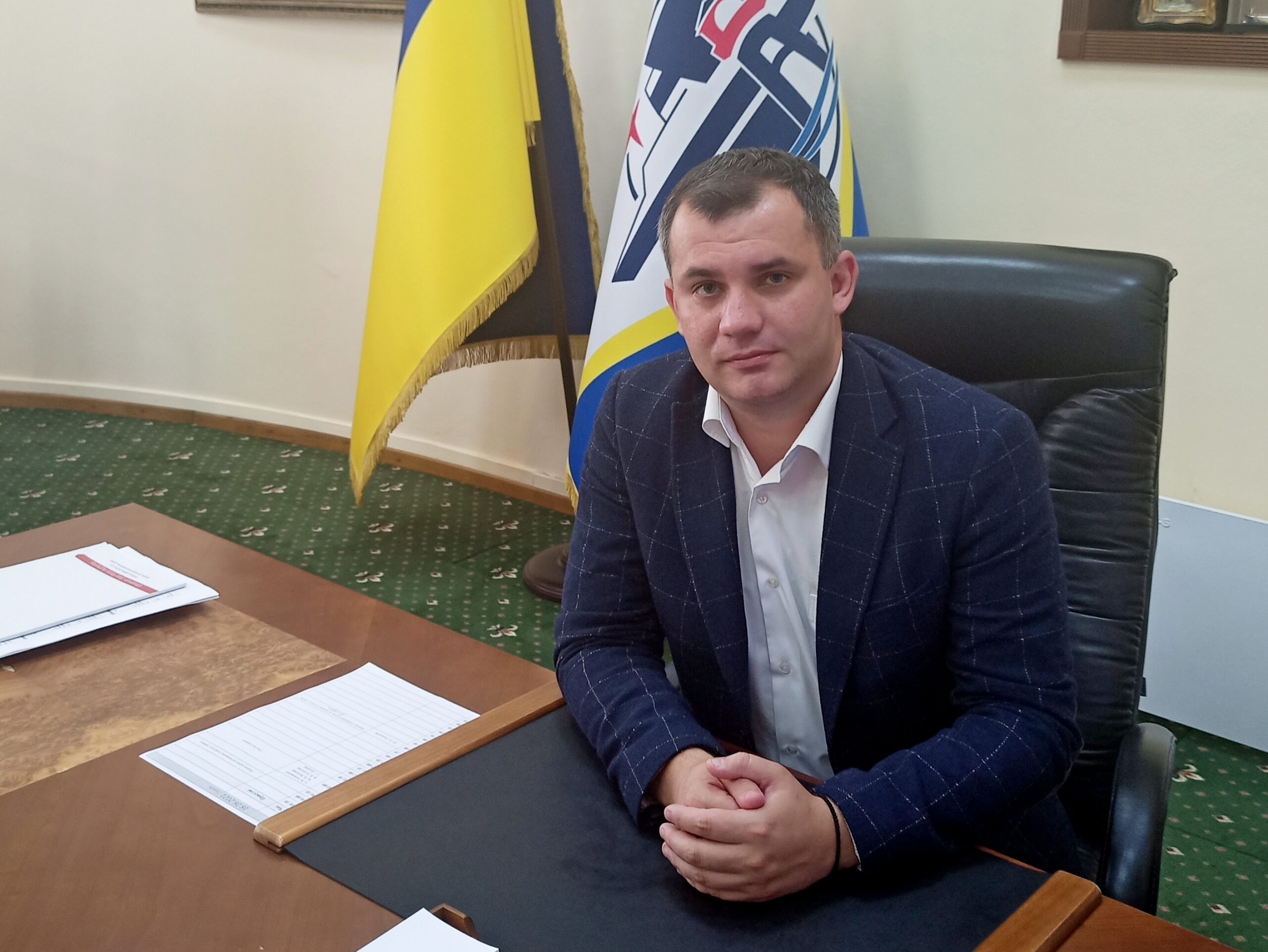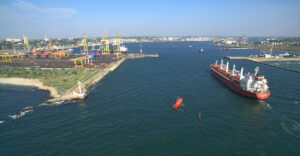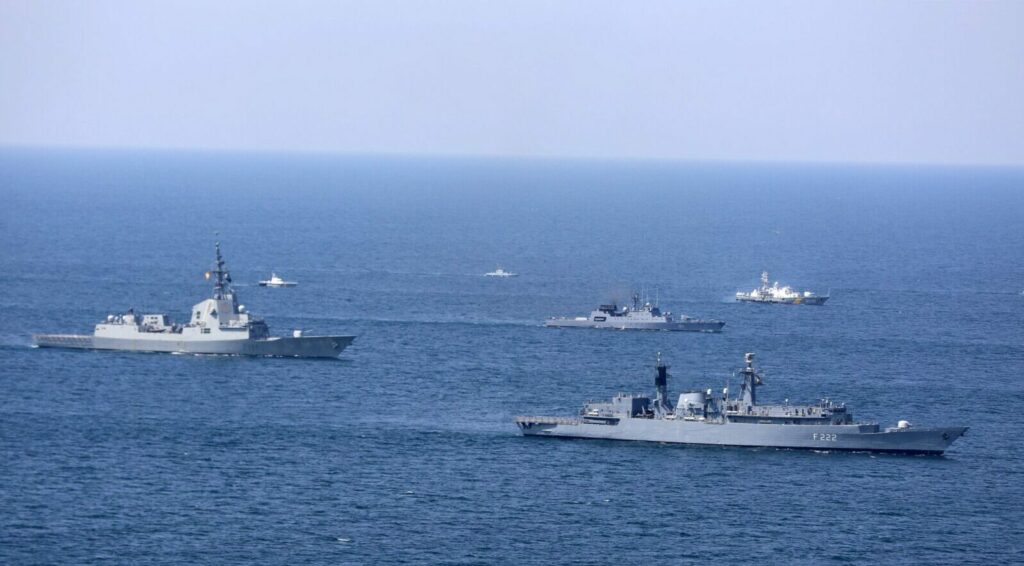“Achieve the set goals despite the circumstances”, – Maksym Lapay, Head of the Odesa branch of the Ukrainian Sea Ports Authority


USM spoke with Maksym Lapay, Head of the Odesa branch of the Ukrainian Sea Ports Authority, about the career, the port and plans for the future.
You started your career in the Odesa port. What was your job?
I feel very fortunate that I have started my career in the main dispatcher’s office – the “think tank” of the port, the “flight control center” if you like. When I came to work, there was no USPA yet – and then the functionality of the enterprise was better. But even then, the Odesa port was different from other ports, because it was this port that became the “cradle” of public-private partnership.
The first position is a planning and cargo traffic engineer. The main responsibility is coordination of plan for the delivery of cargoes by railway. After all, most of cargoes were comming to port by railways. Thousands of wagons move daily across the whole of Ukraine towards the port of Odesa.
But the Odesa-Port station has a certain throughput, and at the peak moments of receiving cargo, this capacity is not enough. And then you need to “enter the game”.
There are regulatory documents according to which wagons in a certain number are distributed among the discharging fronts of stevedoring companies. But that’s all – ideally. If there is an surplusage of wagons at the entrances to the port of the Odesa-Port station and at the unloading fronts, the main dispatching office is tasked with rational confirmation of the shipment of wagons to the port and generation of appropriate delivery plans in order to exclude downtime of transport, capacities, and means of the port.
It is also important to note: in those years there were really large volumes of cargos, the intensity was high. It was very convenient to understand everything – I got into the stream when the work was in full swing. Accordingly, you learn quickly when you come across “problems with asterisks” and you need urgently to solve them.
My second position in the port of Odesa is deputy chief dispatcher for the fleet. A completely different level, the functionality has changed. It was a job when you do not belong to yourself, when you have no day, no night, no vacation, no sick leave. You have to devote your whole life to this work, because if you do it halfway, you will not be able to keep up with all the processes. And getting back to work, even after a rare weekend, is well worth the effort.
If the chief dispatcher is absent, you have to replace him. It is up to you to generate a daily shift plan for the port and monitor its implementation. You decide the issues of the order of placing vessels at berths, and you are also responsible for ensuring equal working conditions for all stevedoring companies. So that everyone adhere to the same rules, know these rules, so that there are no misunderstandings.
If you combine the two abovementioned positions with each other, you get synergy: the planning and cargo traffic engineer makes sure that as many cargoes enter the port as possible, and the task of the deputy for the fleet is that these cargoes leave the port as soon as possible. As a whole ring, the well-coordinated work of a large number of port services, port operators and the efficiency of the enterprise as a whole depend on the literacy of these two specialists. Everything has to be organized rationally and correctly.
Your specialty, “Organization of Transportation and Management of Maritime Transport”, assumes initially an emphasis on management. Have you deliberately chosen a managerial career for yourself?
The key concept here is “maritime transport”. We have mining, metallurgical, agricultural and tourist regions in Ukraine. Odesa and the ports of Big Odesa are the largest maritime transport hub on the Black Sea.
Therefore, it is logical that the majority of Odesa guys, striving to realize themselves in this life, start their careers from the Maritime Academy or from the National Maritime University. It’s fun. Shipping covers 80% of world trade. The horizons for the application of knowledge and abilities are endless. And it doesn’t matter where you realize yourself – in state management or in a private company. In both cases, it is a whopping experience.
As a rule, successful managers are in demand both there and there, and during their careers they change the chair of the head of a state-owned enterprise for a post in a private company more than once. The main thing is to give all the best at every place and show the result.
And what was the internal motivation for the decision to enter the civil service?
It is important to clarify the difference: civil service is still a little different. Before working in the port, I started my career in the Odesa Regional Administration, where there is just the classical understanding of a civil servant, with its own limitations and frameworks. And a port employee … Yes, an employee of a state-owned enterprise, but those restrictions or requirements are no longer there.
Moving on to the question itself, the choice to work for the state was invariable. I understood this even before graduation, I wanted to get into the state machine. And then that experience from the regional administration gave an idea of how the processes that take place in the state are organized.
And if you go back to the past, did you then have ambitions to become the head of the port?
A soldier who doesn’t want to be a general is a bad soldier. But, I will say this – there was not much time to think about it. In those days, the enterprise was headed by talented managers, from whom I wanted to take cue… Maybe there were plans, but this was far from it.
In your opinion, with what new professional qualities did you return to the port of Odesa?
In the management staff of the USPA I have been organizing the operational activities of the seaports of Ukraine for 4 years. This have provided experience for understanding the internal mechanisms of the industry: cargo flows, enterprise capabilities, transport component, balance of interests of shippers, private terminals of state ports.
The port of Odesa is the same industry. There are more than 15 companies that are involved in the reception, registration, transshipment of goods here. The largest container and crude oil port in the country, the leader in the transshipment of steel products, one of the leading ports in the transshipment of grains. The most ambitious investment projects are being implemented here. I am familiar with the organization and coordination of operational activities, I have been working on it in one way or another for more than 10 years.
But being the manager of a thousands employees is a new experience. The super-task is to preserve this staff so that qualified specialists remain at the enterprise, they must receive a normal salary and have social protection. You try, but not everything depends on you. You are an official, you work in a coordinate system that you cannot go beyond. But you are not the first to be put in such a framework, which means that you can do it too.
Moreover, there is someone to look up to. The port of Odesa is a whole galaxy of outstanding managers. The very setting of the port fosters in you the ability to achieve your goals despite the circumstances here…

In December last year, at a meeting of the administration staff of the port of Odesa, you said that you are planning to complete a number of projects of your predecessor. What kind of projects were these and at what stage are they now?
Of the main that we have already completed, this is a large project for the overhaul of the railway tracks at berths № 9 and №10 at Platonovskiy pier. The work has been completed, we have received all the documents, and the facilities have already been put into operation. We are planning a grand opening in the nearest future.
Second: on December 31 of last year, we have completed the construction of a new berth № 1-z with a length of 254 meters, which is part of the transshipment complex of grain cargo with a storage capacity of 241 thousand tons. Then for half a year we were engaged in the paperwork and commissioning of the berth, now there are a few more bureaucratic processes – and we got a new berth – completely functional, morally and technically finished. It will also allow the investor, after the completion of the construction of the silo, the installation of the loading gallery, to start handling vessels. The company plans to finish construction in mid-July, and there should be a grand opening in summer, and the port of Odesa will receive additional capacity.
This is a large-scale investment project implemented jointly by the Ukrainian Sea Ports Authority (berth) and investor Brooklyn-Kiev LLC with the financial support of the European Bank for Reconstruction and Development (rear grain complex).
Also, the port has completed work on the reconstruction of the 1st stage of the transport overpass (cable-stayed section).
Enterprise development program. What projects have you prioritized since the beginning of your work in your current position? What has already been achieved, what remains?
The development plan of the Odesa seaport is divided into short, medium and long term: 5, 10 and 25 years, respectively. The first priority is to continue the construction of a breakwater for the container terminal at the Quarantine Pier, which is operated by Container Terminal Odesa, a subsidiary of HPC (Hamburg Port Consulting GmbH). The examination of the revised project is at the final stage. This year it is planned to resume construction of a breakwater.
In 2021, work on the implementation of two more large-scale investment projects continues: the reconstruction of berth No. 7 in the water area of the Quarantine Harbor and the reconstruction of berths № 12 and 13 of Platonovskiy Pier. Construction work at berth № 7 is progressing ahead of schedule. The completion of the reconstruction is scheduled for 2023.
Completed a set of exploration for the development of a project for the reconstruction of berths № 12, 13 (geology, geodesy). We plan to start contract work after the approval of the project documentation in 2023.
Another large and interesting project is the lengthening of berth № 42 by 115 meters to increase the capacity of the container terminal and to accept large vessels. I would like very much this case to be closed at least on paper within the next two years. How long it will take to complete the work is very difficult to say.
To date, the terms of reference for the development of pre-project proposals for the extension of the berth line № 42 have been agreed with the investor. In terms of this project, in addition to creating a new mooring wall, issues of dredging, relocation of floating docks, and dismantling of the dock pier will be considered.
For the long term, further extension of the berthing line of berth № 42 to berth № 8-z by an additional 240 meters is being considered, with the formation of the territory at the expense of the facilities of the former shipyard “Ukraine”.
In the short term, it is planned to overhaul the highways and overpass of the port, which will ensure the efficient operation of the transshipment complexes and will favorably affect the competitiveness, both in the internal and foreign markets of port services.
To date, the development of design documentation for the overhaul works of the 3rd stage of the transport overpass and port highways has been completed. According to the latest data, the work is planned to start already this year with a breakdown into construction stages with the replacement of the existing bituminous concrete pavement with a more durable SPE pavement (shaped paving elements – concrete tiles).
At what stage is the reconstruction of berth № 7?
More than half of the scope of work on the project has already been completed. Work continues on the section of the 2nd start-up complex with a length of 223.19 meters. The installation of shielding piles of the cordon row with a diameter of 1420 mm, the immersion of the front sheet pile wall, and dismantling of the monolithic head have already been fully completed.
I would like to note that the contractor has gained a high pace – work at the facility is being carried out ahead of the construction schedule. And the speed of work is high, and the solution to the problems that the contractor faced when starting work – everything is being done perfectly.
And what is the state of the other structures of the port now?
Most of the hydrotechnical structures of the Odesa seaport were built in the 50-60s of the last century and require reconstruction, but, in general, their condition is satisfactory. We are planning restoration work, but in accordance with the development program of the Odesa seaport, taking into account the actual technical condition of the structures. After the completion of the reconstruction of berth № 7, we will proceed to the reconstruction of berths № 12 and № 13.
In the nearest future, it is planned to develop the infrastructure of the Shipyard Ukraine, including the hydrotechnical structures of the shipyard, with the financing of the construction at the expense of the investor.
The development of the Voenny pier’s capacities, in particular, the renewal of berths № 22-24, is relevant today. The reconstruction provides for the restoration of the mooring front with a total length of 576 m.
Scheduled repair works are carried out annually at the berths of the Odesa seaport. Especially in terms of the safety of the load-bearing structural elements of hydrotechnical structures.
This year, repairs are planned at berths № 9, 10 of Platonovskiy pier, berth № 14 of Novaya Harbor, berth № 42 of Khlebnaya Harbor and berth № 2 of Karantinnaya Harbor. For the next year, it is planned to repair berth № 46 of the Khlebnaya Harbor and berths № 3-4 of the Karantinnaya Harbor.
Is there a need for port dredging now?
Today, market conditions require the acceptance of modern fleet vessels, draft of which is maximum permissible for calling at the Odesa seaport. So, in the water area of the Karantinnaya Harbor, it is planned to dredge up to 13.5 meters, in the waters of Lanzheronovskaya and Novaya Harbors – up to 15 meters, in the water area of the Zavodskoy harbor – up to 13.5 meters. At the same time, it is planned to dredge the Port’s approaching channel to 14.5 meters with a subsequent increase in depth to 15.7 meters.
Recently, the port has set an absolute record for the daily handling of trucks. To what extent did the Time Slot system favour to the record? What other factors led to this indicator?
Ensuring the check-in of transport is the direct responsibility and area of responsibility of the port administration. That is why we put into operation the Time-Slot IT service and placed a monitor of information about free places for arrival in the Sukhoi port. In general, this was another step towards the implementation of our policy of publicity and transparency in relations with business.
The production operation of the Time-Slot software, which took into account all the wishes and suggestions of Alexander Golodnitsky (head of the USPA State Enterprise – ed.), Our business partners – participants in trucks logistics, gave us a real opportunity to improve the quality of the service provided, efficiency of work planning and almost double the processing rates of trucks heading to the port of Odesa.
As a result: on May 13, specialists of the Cargo Transportation and Escort Service served 2,171 vehicles with commercial cargo to enter the port, and 2,140 vehicles to exit. This became an absolute record in the daily handling of tucks in the entire history of the port.
Put simply: “Time-Slot” helps to prevent congestions at the entrance to the port, to warn drivers in advance by giving them the necessary information and to prevent the rhythm of car reception from being interrupted.
The system itself has great potential, there is a room for improvement. We have attracted container terminals to the system, we also cooperate with forwarders and associations. We collect opinions, suggestions, we want to bring “Time-Slot” to the supreme convenience and customer focus. Overall, we are happy with this system.
At the moment, the construction of an alternative road to the Odesa port is underway. How will it benefit the port?
From our side it is difficult to comment – the project is being implemented by the road service. We are not specialists in road construction and have never pretended to be. But, in general, the more infrastructure, the more entrances to the port, the better.
The construction object itself is included to the list of measures of the Odesa Sea Port Development Plan. As far as we know, the difficulty of implementation lies in the fact that the road passes in difficult hydrogeological conditions. Another technically challenging aspect is the need to build a vehicle sludge area and a site for weight-size control.
It should be noted that the checkpoint is an integral part of the transport corridor to the Odesa seaport (without which it is excluded that vehicles can enter the port territory by an alternative road).
But, of course, we are closely following the implementation process of this project – after all, we will become its final user. It is required to build a security station. We plan to construct the security station (engineering networks, equipment and auxiliary facilities) on our own.
In general, the implementation of this project will allow heavy duty vehicles to enter the port territory freely, bypassing the private terminal. This decision will allow attracting new cargo flows and increasing the company’s cargo turnover. Also, the construction of an alternative road to the Odesa seaport will unload the roads of Odesa, which will favorably affect the condition of city roads and improve the environment.
Concession of the passenger complex of the Odesa port: what is expected and at what stage is the transfer of the complex to the concession now?
Today, the largest passenger complex in the Odesa port in Ukraine requires major reconstruction. And, subsequently, large investments. State Enterprise “USPA” does not have such funds. To date, state-owned enterprises pay dividends at a level of 80%.
Howport infrastructure can be developed, giving the lion’s share of its own sources of development to the state? The only option is to find a private partner who will modernize the complex, rethink its philosophy as a public cultural and social space of Southern Palmyra, and will further develop it in the direction of attracting new investments. At the same time, the main function of the Passcomplex – handling and maintenance of cruise liners – will remain unchanged.
Currently, negotiations are underway with a potential private partner – UKK De Jure LLC. In accordance with the Law of Ukraine “On Concession”, work is underway to prepare a proposal for a public-private partnership in the form of a concession, in particular, a PFS of the project is being developed, based on the results of which an analysis of the effectiveness will be carried out and a decision on the feasibility of a concession will be made.
What is the current situation in the field of cruise tourism? Before the pandemic, an increase in the number of cruise liner calls was expected in the port of Odesa, what are the forecasts for 2021?
Thanks to the active and well-coordinated work of the Black Sea Working Group, created at the initiative of the Odesa port, and the promotion of our tourism potential on international sites, the restoration of cruise communications in the Black Sea region was supposed to be back in 2020. The port of Odesa received 11 applications from cruise companies for upcoming calls. But the COVID-19 pandemic that has suddenly hit the world has forced the global cruise community to temporarily suspend all cruise operations indefinitely.
For 2021, we received 22 applications for cruise liner calls from such world famous operators as Azamara Cruises, SilverSea Cruises, Fred Olsen Cruise Line, Phoenix Reisen Crystal Cruises, etc. The season was supposed to begin on April 30. But, taking into account the fact that only a few cruise companies are starting to gradually restore passenger traffic in nearby regions, introducing new health protocols on board and filling vessels by no more than 50%, naturally, many upcoming calls to the Odesa port have now been canceled. There is only a small hope for the end of September and October of this year.
But we are not losing our optimism. There is every chance to open the cruise season for 2022. To date, the port of Odesa has received 29 applications for cruise liner calls. And for 2023 – 15 applications.
In general, this is how the situation in the port looks now. We can confidently say that we are implementing our plans at the right pace, and new projects only increase the capacity of the Odesa port.





